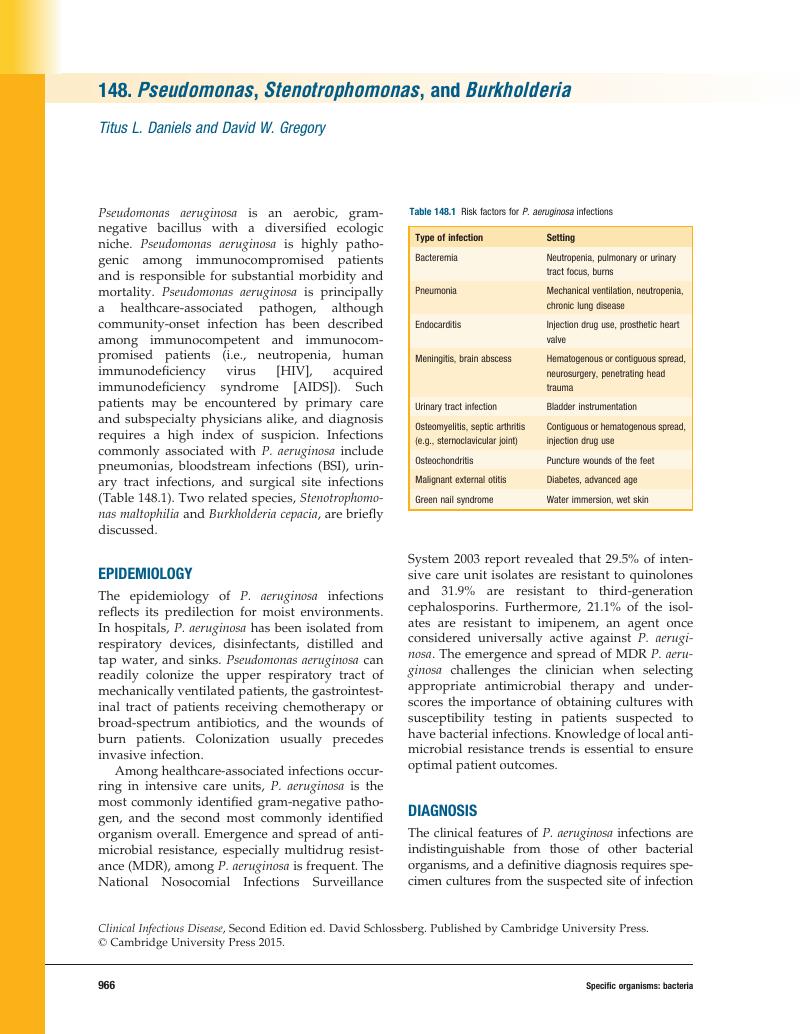Book contents
- Frontmatter
- Dedication
- Contents
- List of Contributors
- Preface
- Part I Clinical syndromes: general
- Part II Clinical syndromes: head and neck
- Part III Clinical syndromes: eye
- Part IV Clinical syndromes: skin and lymph nodes
- Part V Clinical syndromes: respiratory tract
- Part VI Clinical syndromes: heart and blood vessels
- Part VII Clinical syndromes: gastrointestinal tract, liver, and abdomen
- Part VIII Clinical syndromes: genitourinary tract
- Part IX Clinical syndromes: musculoskeletal system
- Part X Clinical syndromes: neurologic system
- Part XI The susceptible host
- Part XII HIV
- Part XIII Nosocomial infection
- Part XIV Infections related to surgery and trauma
- Part XV Prevention of infection
- Part XVI Travel and recreation
- Part XVII Bioterrorism
- Part XVIII Specific organisms: bacteria
- 123 Actinomycosis
- 124 Anaerobic infections
- 125 Anthrax and other Bacillus species
- 126 Bartonella bacilliformis
- 127 Cat scratch disease and other Bartonella infections
- 128 Bordetella
- 129 Branhamella–Moraxella
- 130 Brucellosis
- 131 Campylobacter
- 132 Clostridium
- 133 Corynebacteria
- 134 Enterobacteriaceae
- 135 Enterococcus
- 136 Erysipelothrix
- 137 HACEK
- 138 Helicobacter pylori
- 139 Gonococcus: Neisseria gonorrhoeae
- 140 Haemophilus
- 141 Legionellosis
- 142 Leprosy
- 143 Meningococcus and miscellaneous neisseriae
- 144 Listeria
- 145 Nocardia
- 146 Pasteurella multocida
- 147 Pneumococcus
- 148 Pseudomonas, Stenotrophomonas, and Burkholderia
- 149 Rat-bite fevers
- 150 Salmonella
- 151 Staphylococcus
- 152 Streptococcus groups A, B, C, D, and G
- 153 Viridans streptococci
- 154 Poststreptococcal immunologic complications
- 155 Shigella
- 156 Tularemia
- 157 Tuberculosis
- 158 Nontuberculous mycobacteria
- 159 Vibrios
- 160 Yersinia
- 161 Miscellaneous gram-positive organisms
- 162 Miscellaneous gram-negative organisms
- Part XIX Specific organisms: spirochetes
- Part XX Specific organisms: Mycoplasma and Chlamydia
- Part XXI Specific organisms: Rickettsia, Ehrlichia, and Anaplasma
- Part XXII Specific organisms: fungi
- Part XXIII Specific organisms: viruses
- Part XXIV Specific organisms: parasites
- Part XXV Antimicrobial therapy: general considerations
- Index
- References
148 - Pseudomonas, Stenotrophomonas, and Burkholderia
from Part XVIII - Specific organisms: bacteria
Published online by Cambridge University Press: 05 April 2015
- Frontmatter
- Dedication
- Contents
- List of Contributors
- Preface
- Part I Clinical syndromes: general
- Part II Clinical syndromes: head and neck
- Part III Clinical syndromes: eye
- Part IV Clinical syndromes: skin and lymph nodes
- Part V Clinical syndromes: respiratory tract
- Part VI Clinical syndromes: heart and blood vessels
- Part VII Clinical syndromes: gastrointestinal tract, liver, and abdomen
- Part VIII Clinical syndromes: genitourinary tract
- Part IX Clinical syndromes: musculoskeletal system
- Part X Clinical syndromes: neurologic system
- Part XI The susceptible host
- Part XII HIV
- Part XIII Nosocomial infection
- Part XIV Infections related to surgery and trauma
- Part XV Prevention of infection
- Part XVI Travel and recreation
- Part XVII Bioterrorism
- Part XVIII Specific organisms: bacteria
- 123 Actinomycosis
- 124 Anaerobic infections
- 125 Anthrax and other Bacillus species
- 126 Bartonella bacilliformis
- 127 Cat scratch disease and other Bartonella infections
- 128 Bordetella
- 129 Branhamella–Moraxella
- 130 Brucellosis
- 131 Campylobacter
- 132 Clostridium
- 133 Corynebacteria
- 134 Enterobacteriaceae
- 135 Enterococcus
- 136 Erysipelothrix
- 137 HACEK
- 138 Helicobacter pylori
- 139 Gonococcus: Neisseria gonorrhoeae
- 140 Haemophilus
- 141 Legionellosis
- 142 Leprosy
- 143 Meningococcus and miscellaneous neisseriae
- 144 Listeria
- 145 Nocardia
- 146 Pasteurella multocida
- 147 Pneumococcus
- 148 Pseudomonas, Stenotrophomonas, and Burkholderia
- 149 Rat-bite fevers
- 150 Salmonella
- 151 Staphylococcus
- 152 Streptococcus groups A, B, C, D, and G
- 153 Viridans streptococci
- 154 Poststreptococcal immunologic complications
- 155 Shigella
- 156 Tularemia
- 157 Tuberculosis
- 158 Nontuberculous mycobacteria
- 159 Vibrios
- 160 Yersinia
- 161 Miscellaneous gram-positive organisms
- 162 Miscellaneous gram-negative organisms
- Part XIX Specific organisms: spirochetes
- Part XX Specific organisms: Mycoplasma and Chlamydia
- Part XXI Specific organisms: Rickettsia, Ehrlichia, and Anaplasma
- Part XXII Specific organisms: fungi
- Part XXIII Specific organisms: viruses
- Part XXIV Specific organisms: parasites
- Part XXV Antimicrobial therapy: general considerations
- Index
- References
Summary

- Type
- Chapter
- Information
- Clinical Infectious Disease , pp. 966 - 974Publisher: Cambridge University PressPrint publication year: 2015



